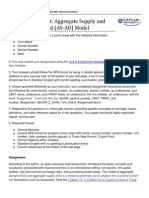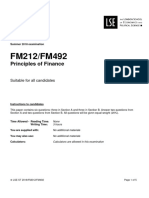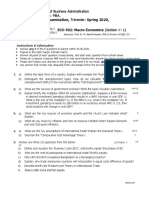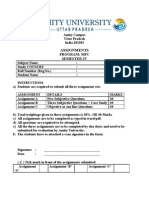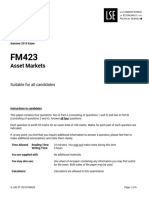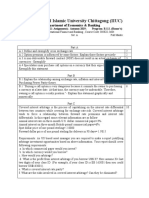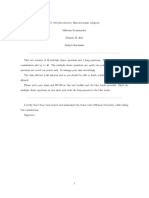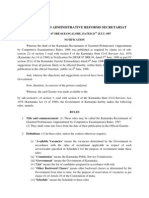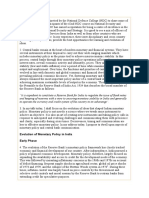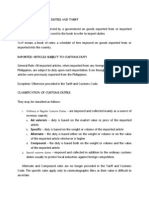Ever Necessary 2. Support The Answers With Relevant Data and Country - Illustrations Where Ever Necessary
Ever Necessary 2. Support The Answers With Relevant Data and Country - Illustrations Where Ever Necessary
Uploaded by
Amith RajCopyright:
Available Formats
Ever Necessary 2. Support The Answers With Relevant Data and Country - Illustrations Where Ever Necessary
Ever Necessary 2. Support The Answers With Relevant Data and Country - Illustrations Where Ever Necessary
Uploaded by
Amith RajOriginal Title
Copyright
Available Formats
Share this document
Did you find this document useful?
Is this content inappropriate?
Copyright:
Available Formats
Ever Necessary 2. Support The Answers With Relevant Data and Country - Illustrations Where Ever Necessary
Ever Necessary 2. Support The Answers With Relevant Data and Country - Illustrations Where Ever Necessary
Uploaded by
Amith RajCopyright:
Available Formats
JSS MAHAVIDYAPEETHA
SRI JAYACHAMARAJENDRA COLLEGE OF ENGINEERING MYSORE 570006
An Autonomous Institution under Visvesvaraya Technological University, Belgaum
4TH Semester MBA Degree EVEN SEMESTER JUNE 2011 Branch Section Date Duration of Exam Time : : 09MBA4F4 : : : : MBA COM M ON
SET 2
Name of the Paper Setter: Dr.(Mrs)Bettina .C.S
INTERNATIONAL FINANCIAL MANAGEMENT 3 hours 2.00 pm to 5.00 pm Maximum Marks: 100
Instructions to the Candidates: 1. Answers must be clear, complete, concise and comprehensive. 2. Mention the Section and corresponding Question Number boldly at the left hand side. 3. Depiction of Models must be neat and complete
Note: 1. Answers must be supported by graphs and arithmetical illustrations where ever necessary 2. Support the answers with relevant data and country - illustrations where ever necessary
Section A: Answer any 5 questions each carrying 3 marks 3X5 = 15 Marks
A1) Give a block diagram of the objectives of International Expansion. A2) Mention the pointers of a successful Joint Venture. A3) What are the three key components of financial account? A4) How does outsourcing affect balance of trade? A5) Mention the location of the four Biggest Foreign Exchange Market
A6) Mention the most frequently traded currency pairs
A7) What are Futures & Options? A8) What is Triffin Paradox?
Section B: Answer any 5 questions each carrying 7 marks
7X5 = 35 Marks
B1) Is ALL currency convertible? Explain B2) International movement of capital finds its origin in Product Life Cycle theory of Vernon. Explain B3) How do the unstable exchange rates impact balance of trade of a country. B4) Give a brief account on different foreign exchange instruments. B5) Analyse qualitatively the factors responsible for the deficits in balance of payments. B6) Suppose the Canadian spot exchange rate is 1.18 Canadian dollars per U.S. dollar. U.S. inflation is expected to be 3% per year and Canadian inflation is expected to be 2%. B7) Do you expect the U.S. dollar to appreciate or depreciate relative to the Canadian dollar? B8) What is the expected exch. rate in one year?
Section C: Answer any 5 questions each carrying 10 marks
10X5 = 50 Marks
C1) Briefly explain the structure of Foreign Exchange Markets C2) a. How do government controls affect exchange rates? b. Assume that Japanese government relaxes its controls on imports by Japanese companies. Other things being equal, trace the following: a. US demand for Japanese Yen b. Supply of Yen for sale c. Equilibrium value of Yen. C3) Critically examine the Purchasing Power Parity (PPP) theory C4) The stability of the U.S. dollar has made it the most widely traded in the world. Elucidate this statement C5) Explain the cash flow of an MNC with the help of a diagram. C6) Bring out the importance of transfer pricing from MNCs perspective
C7) Assume Aviva has contracted to sell 100 pairs of jeans per year to Britain at $ 24 per pair to buy 200 yards of denim from Britain in this same period for 2 per yard. Note that 2 yards of denim are required per pair and that the labour cost for each pair is $8. When at the time of contract, the exchange rate is S ($/) =1.5 and that the dollar is then devalued to S ($/F) =2.0, elasticity of demand for Aviva Jeans in Britain is -2 and that after the contract expires Aviva raises the price of jeans to $25 per pair. a. b. Calculate the gains/losses from the devaluation on the jeans sold and on denim bought at the contracted prices. Calculate the gains/losses from extra competitiveness of Avivas jeans from the operative exposure. a. US firms prefer to engage in Foreign Direct Investment (FDI)in Mexico rather than Canada b. US firms commonly use joint ventures as a strategy to enter China c. Europe is not considered as a location for FDI because of Euros value.
C8) Give reasons for the following:
You might also like
- Week 6 Quiz SolutionsDocument12 pagesWeek 6 Quiz SolutionsMehwish Pervaiz100% (1)
- Econ 105 Final Exam (Summer 2020)Document7 pagesEcon 105 Final Exam (Summer 2020)Rituraaj SathyaNo ratings yet
- International Finance PDFDocument5 pagesInternational Finance PDFDivakara ReddyNo ratings yet
- AP Exam Past Exam PaperDocument3 pagesAP Exam Past Exam PaperAnnaLuxeNo ratings yet
- BU204 Unit8 RubricDocument4 pagesBU204 Unit8 RubricAli Ranjha0% (1)
- Fin 4710 Final Assessment 2Document7 pagesFin 4710 Final Assessment 2SakiNo ratings yet
- International Finance 2021-22Document3 pagesInternational Finance 2021-22NAITIK SHAHNo ratings yet
- Finance Systems Information Analysis QuestionsDocument15 pagesFinance Systems Information Analysis QuestionsNivneth PeirisNo ratings yet
- FM212 2018 PaperDocument5 pagesFM212 2018 PaperSam HanNo ratings yet
- Eet 201 Macroeconomics Theory IiDocument2 pagesEet 201 Macroeconomics Theory Iidragon labNo ratings yet
- FD End Term QP - 2021-22Document3 pagesFD End Term QP - 2021-22xyzcompany52No ratings yet
- Ch8 Practice ProblemsDocument5 pagesCh8 Practice Problemsvandung19No ratings yet
- Sem 2 Papers 2021 PDFDocument17 pagesSem 2 Papers 2021 PDFsahil sharmaNo ratings yet
- Final Exam ECO 502 Sec 1 Spring 2020 QSDocument1 pageFinal Exam ECO 502 Sec 1 Spring 2020 QSDiptoDCastle100% (1)
- CFI5214201510 Multinational Business Finance and TradeDocument7 pagesCFI5214201510 Multinational Business Finance and TradeNelson MrewaNo ratings yet
- AP Macroeconomics 2013 Free-Response Questions: About The College BoardDocument3 pagesAP Macroeconomics 2013 Free-Response Questions: About The College BoardWayne Sawyer100% (1)
- Jun18l1-Ep04 QDocument18 pagesJun18l1-Ep04 QjuanNo ratings yet
- NU Last Year Question of Bank Risk, Financial Market and OthersDocument6 pagesNU Last Year Question of Bank Risk, Financial Market and Othersmd. polashNo ratings yet
- Business XI DT 3 Question PaperDocument7 pagesBusiness XI DT 3 Question PaperSartikacandradewi SinagaNo ratings yet
- AP Exam Past Exam PaperDocument3 pagesAP Exam Past Exam PaperAnnaLuxeNo ratings yet
- Ec1002 Za - 2019Document7 pagesEc1002 Za - 2019Noor JassimNo ratings yet
- Macroeconomics 17th Batch 2023Document2 pagesMacroeconomics 17th Batch 2023nipa.misNo ratings yet
- Bba 304Document4 pagesBba 304hodmbaalpineNo ratings yet
- Question Bank 2 - SEP2019Document6 pagesQuestion Bank 2 - SEP2019Nhlanhla ZuluNo ratings yet
- Fin 4710 Sem 2 1819Document8 pagesFin 4710 Sem 2 1819SakiNo ratings yet
- 2022 FTX3044F Test 1Document9 pages2022 FTX3044F Test 1tiffanypekeur001No ratings yet
- ECONOMICSEXAMQUESTIONSFORSS3FIRSTTERM-_1731407008571Document12 pagesECONOMICSEXAMQUESTIONSFORSS3FIRSTTERM-_1731407008571calebraji2020No ratings yet
- BCM 3113 Exam 2022 AprilDocument4 pagesBCM 3113 Exam 2022 Aprilkorirenock764No ratings yet
- International Finance, HedgeDocument7 pagesInternational Finance, HedgeJasmin HallNo ratings yet
- 2015 Mid Term Exam ACFI305Document8 pages2015 Mid Term Exam ACFI305Anna KongNo ratings yet
- Attempt Four Questions, Three From Section A and One From Section B 3. Start The Solution To Each Full Question On A Fresh Page of The Answer SheetDocument3 pagesAttempt Four Questions, Three From Section A and One From Section B 3. Start The Solution To Each Full Question On A Fresh Page of The Answer SheetFungai MukundiwaNo ratings yet
- This Paper Is Not To Be Removed From The Examination HallDocument55 pagesThis Paper Is Not To Be Removed From The Examination HallSithmi HimashaNo ratings yet
- FEDocument12 pagesFEThaddee Nibamureke0% (1)
- CE - Final Exam - Spring 2006 - Version 4 - With Solutions-1Document18 pagesCE - Final Exam - Spring 2006 - Version 4 - With Solutions-1Dirit SanghaniNo ratings yet
- 2017 12 Economics Sample Paper 02 QPDocument3 pages2017 12 Economics Sample Paper 02 QPahmadshahwaqarNo ratings yet
- CAT 2-Fundamentals of EconomicsDocument7 pagesCAT 2-Fundamentals of Economicstrevor.gatuthaNo ratings yet
- Economics Sample Paper 1Document3 pagesEconomics Sample Paper 1L IneshNo ratings yet
- FN2190 Ota Final Exam PaperDocument7 pagesFN2190 Ota Final Exam PaperNoor NoorNo ratings yet
- August 2021 WKDDocument3 pagesAugust 2021 WKDaronkaruga0987No ratings yet
- Assignment 6 2020Document7 pagesAssignment 6 2020林昀妤100% (1)
- FM423 2017Document9 pagesFM423 2017tonggennnNo ratings yet
- FM423 2019Document6 pagesFM423 2019tonggennnNo ratings yet
- Mid Term TestDocument2 pagesMid Term Testht.thuyduongggNo ratings yet
- 2019 ZaDocument5 pages2019 ZaChandani FernandoNo ratings yet
- ACCG329 Sample Exam PaperDocument25 pagesACCG329 Sample Exam PaperLinh Dieu NghiemNo ratings yet
- BBAE Intake K63_Macro Final Exam_No. 2_with KeysDocument3 pagesBBAE Intake K63_Macro Final Exam_No. 2_with Keysjeonhana20031997No ratings yet
- Macroeconomics Assignment 2Document4 pagesMacroeconomics Assignment 2reddygaru1No ratings yet
- TWO (2) Questions From SECTION B in The Answer Booklet Provided. All Question Carry EqualDocument4 pagesTWO (2) Questions From SECTION B in The Answer Booklet Provided. All Question Carry EqualnatlyhNo ratings yet
- Bec 3303 Money and BankingDocument2 pagesBec 3303 Money and Bankingwilliammuiakioko4No ratings yet
- ECO 409 - Final Spring 2022 theoryDocument2 pagesECO 409 - Final Spring 2022 theorySabaNo ratings yet
- Final Correction International Finance 2022 - CopieDocument7 pagesFinal Correction International Finance 2022 - Copieschall.chloeNo ratings yet
- SET - A (For Odd Class ID)Document2 pagesSET - A (For Odd Class ID)farhanNo ratings yet
- 250 Question PaperDocument2 pages250 Question PaperPacific TigerNo ratings yet
- AP Exam Past Exam PaperDocument3 pagesAP Exam Past Exam PaperAnnaLuxeNo ratings yet
- Ec1002 ZB - 2019Document7 pagesEc1002 ZB - 2019violapoonNo ratings yet
- Midterm ExamDocument6 pagesMidterm ExamBahar SamiNo ratings yet
- Macro PDF Important QuestionsDocument2 pagesMacro PDF Important Questionsakhilsharmac1140No ratings yet
- Assignment FIN205 S2 - 2017Document4 pagesAssignment FIN205 S2 - 2017Japheth CapatiNo ratings yet
- 12th Eco Rrs QuarterlyDocument6 pages12th Eco Rrs QuarterlyAditya ShrivastavaNo ratings yet
- Foundations of Global Financial Markets and Institutions, fifth editionFrom EverandFoundations of Global Financial Markets and Institutions, fifth editionRating: 5 out of 5 stars5/5 (2)
- Bond Markets, Analysis, and Strategies, tenth editionFrom EverandBond Markets, Analysis, and Strategies, tenth editionRating: 3 out of 5 stars3/5 (9)
- HGKKKDocument4 pagesHGKKKAmith RajNo ratings yet
- Anoop Raj Naval M8892582525 437, 'Hamsanaadha" Behind Dhobi Ghat, Kesare II Stage,, R.S.Naidu Nagar Behind D Hobi Ghat, Mysore, Karnataka - 570007Document1 pageAnoop Raj Naval M8892582525 437, 'Hamsanaadha" Behind Dhobi Ghat, Kesare II Stage,, R.S.Naidu Nagar Behind D Hobi Ghat, Mysore, Karnataka - 570007Amith RajNo ratings yet
- BMTC Pattar Savita 0493Document88 pagesBMTC Pattar Savita 0493Amith RajNo ratings yet
- LESDocument14 pagesLESMrChwet AumNo ratings yet
- © 2004 The Mcgraw-Hill Companies, Inc. All Rights Reserved. Mcgraw-Hill/IrwinDocument22 pages© 2004 The Mcgraw-Hill Companies, Inc. All Rights Reserved. Mcgraw-Hill/IrwinAmith RajNo ratings yet
- Kopac Consulting Code of Business ConductDocument5 pagesKopac Consulting Code of Business ConductAmith RajNo ratings yet
- Global Rock Drilling Jumbo Industry 2015 Market Research ReportDocument6 pagesGlobal Rock Drilling Jumbo Industry 2015 Market Research Reportapi-289095994No ratings yet
- Chapter 13Document54 pagesChapter 13butterfly_irinaNo ratings yet
- Ecological Economics Lecture 01Document5 pagesEcological Economics Lecture 01Mamun RanaNo ratings yet
- Step by Step - Linear Acceleration Method - Inelastic AnalysisDocument78 pagesStep by Step - Linear Acceleration Method - Inelastic Analysisshams sultaniNo ratings yet
- Strategic Planning in RetailingDocument30 pagesStrategic Planning in RetailingmoniquecarzonNo ratings yet
- 311FA14syllabus 140923Document8 pages311FA14syllabus 140923Grant NicholasNo ratings yet
- Price DeterminationDocument2 pagesPrice DeterminationSikander BehalNo ratings yet
- Islamic Shari'a Concepts Governing Islamic Banking FinanceDocument44 pagesIslamic Shari'a Concepts Governing Islamic Banking FinanceYusuf KaziNo ratings yet
- Session 1 - MAEC PDFDocument18 pagesSession 1 - MAEC PDFSwetha RavichandranNo ratings yet
- Osztroluczki Istvanne - Palmai Orsolya - The Basisc of Business English For EconomicsDocument78 pagesOsztroluczki Istvanne - Palmai Orsolya - The Basisc of Business English For EconomicsErvin CsorbaNo ratings yet
- GAMS ManualDocument82 pagesGAMS ManualHector OwenNo ratings yet
- Economics WordsearchDocument1 pageEconomics WordsearchSandy SaddlerNo ratings yet
- Syllabus Weekly Breakdown of The 6-Week Crash Revision PlanDocument2 pagesSyllabus Weekly Breakdown of The 6-Week Crash Revision PlanSehar SajjadNo ratings yet
- Managerial Economics Paper Kmbn102-2022Document2 pagesManagerial Economics Paper Kmbn102-2022Candy ManNo ratings yet
- Generalvalue Chain Analysis Soybeans MalawiDocument67 pagesGeneralvalue Chain Analysis Soybeans MalawideepashajiNo ratings yet
- Province of The Eastern Cape Education Directorate Curriculum Fet Programmes Lesson Plans Economics Grade 12 Term 3Document21 pagesProvince of The Eastern Cape Education Directorate Curriculum Fet Programmes Lesson Plans Economics Grade 12 Term 3Anonymous gPhRqg3100% (4)
- Beautiful Green World? On The Myth of The Green Capitalist EconomyDocument48 pagesBeautiful Green World? On The Myth of The Green Capitalist EconomyTerry Townsend, EditorNo ratings yet
- Full Download Handbook of International Economics: International Macroeconomics, Vol. 6 Gita Gopinath PDFDocument64 pagesFull Download Handbook of International Economics: International Macroeconomics, Vol. 6 Gita Gopinath PDFaljhnitonaco100% (6)
- DIP Sri LankaDocument3 pagesDIP Sri LankaRuwan Dissanayake100% (1)
- Chapter 6 Supply, Demand, and Government PoliciesDocument30 pagesChapter 6 Supply, Demand, and Government Policies刘佳煊100% (1)
- IAS 21 International Accounting Standards 21Document80 pagesIAS 21 International Accounting Standards 21John Rey Bantay RodriguezNo ratings yet
- Evolution of Monetary Policy in India Early PhaseDocument15 pagesEvolution of Monetary Policy in India Early PhaseNitesh kuraheNo ratings yet
- David Sm14 Inppt05Document50 pagesDavid Sm14 Inppt05alieze1150% (2)
- Chapter-8 International Equity MarketsDocument31 pagesChapter-8 International Equity MarketsJignesh PrajapatiNo ratings yet
- TPG PE PresentationDocument37 pagesTPG PE Presentationnicolee593100% (1)
- Meaning of Customs Duties and TariffDocument4 pagesMeaning of Customs Duties and TariffLei Chumacera100% (1)
- Cfa WMN SCHLRSHPDocument1 pageCfa WMN SCHLRSHPAditi ParvathamNo ratings yet
- Economics Answers 2Document14 pagesEconomics Answers 2Rakawy Bin RakNo ratings yet
- Godley (1992) - Maastricht and All ThatDocument5 pagesGodley (1992) - Maastricht and All ThatmarceloscarvalhoNo ratings yet




